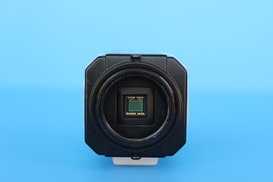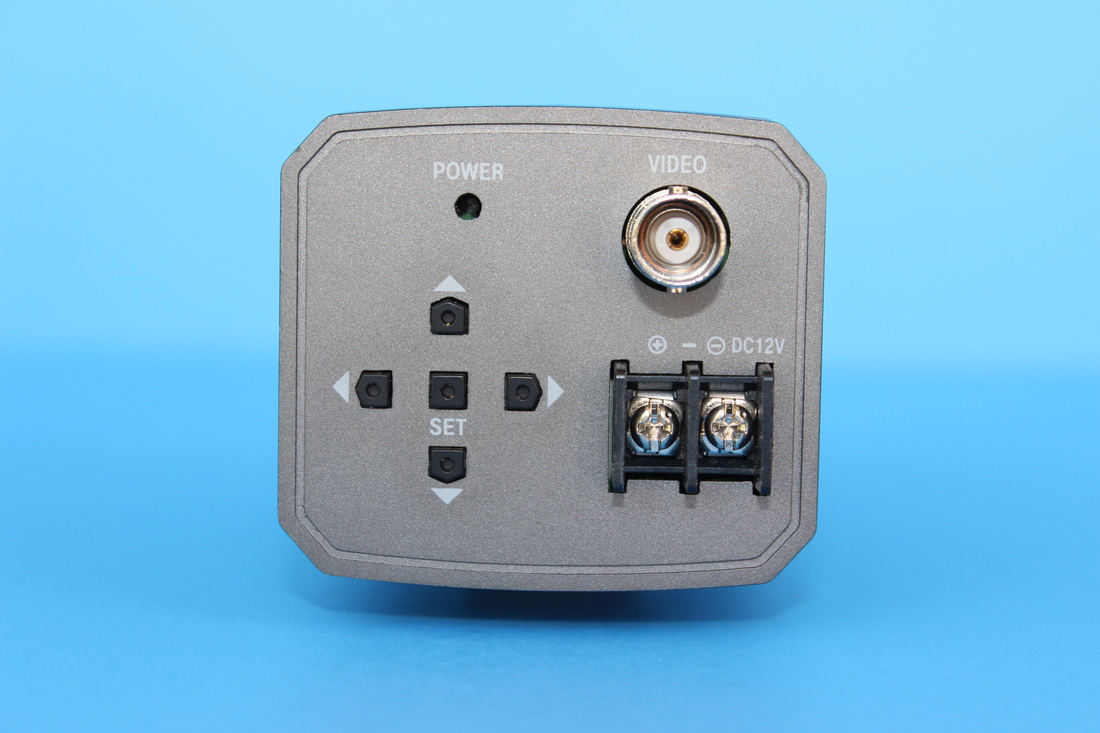 This is an expanded and updated version of the article I posted on Cloudy Nights in November 2014. It is not necessary to spend hundreds of dollars to get started with some surprisingly good performing video cameras. I recently experimented with three astrovideo cameras which are available for less than $110. These are the Astro-Video Systems DSO-1, the Mallincam Micro-Ex and the Samsung SCB2000. In addition to the camera, you will need a composite video cable, a C-Mount adaptor and a 12VDC transformer or a cable with a cigarette plug and a 12VDC battery. Both the DSO-1 and Micro-Ex can be purchased as packages with the necessary accessories for less than $200, or these can be purchased separately on-line or at your local electronics store for less than $100. For anyone looking to get started in deep sky video astronomy, any of these cameras provides a low cost point of entry. They all use Sony's 1/3" color CCDs with high sensitivity which provides lots of detail with even very short exposures. The camera menus are controlled by five small buttons on the backside. Optional hand controls make it much easier to change menu settings, given that the buttons are very small and hard to see in the dark, especially as the scope slews across the sky and the camera orientation changes. The Micro-Ex and DSO-1 can also be computer controlled with an additional cable which attaches to the serial connection on the back of the camera and uses a serial to USB adapter to connect to the computer. Additional software is required to control the camera menu settings from the computer and is available as a free download from the manufacturer's site. All three cameras have a single bayonet style video output connection on the back of the camera (called a BNC connector) which is designed for a 75ohm shielded cable. These cables are available in two types. First, with the BNC connector on both ends of the cable, which requires a BNC to RCA adapter on the end connected to the monitor. Second, with the BNC connector on one end (camera output) and a composite video connector on the opposite end (monitor input). Either cable works by connecting the RCA adapter or the composite video connector to the yellow composite video input on the monitor. To display images on the computer and/or to capture images, the video output must be connected to the video input of a video capture device such as a Pinnacle Dazzle or similar. The USB output of the capture device is then connected to one of the USB inputs of the computer. Additionally, video capture software must be run on the computer to display and capture images. There are many free video capture software applications such as AmCap or SharpCap and some inexpensive software with some very good additional features like Miloslick and AstroLive. The key to a deep sky video camera is the ability to manually control exposure, gain, and white balance which all three cameras support. Other additional features, like in camera image stacking/averaging, zoom, cross-hairs, etc vary by camera. All three cameras have pros and cons about them, but all are capable of providing lots of satisfaction and are good choices to start in video astronomy. In addition to features, don't forget to consider manufacturer's warranties, support, history and reputation. Samsung SCB 2000  This camera is sold as a video surveillance camera, but has been successfully used for deep sky video. It uses the 1/3" format Sony ICX638 Super HAD II color CCD with 768 x 494 active pixels (379K). Each pixel is 6.35 x 7.40 microns in size. The camera ships with an IR-cut filter installed in front of the CCD, which should be removed to improve the camera's sensitivity in the all-important Halpha part of the spectrum. This is easily done in about 10 minutes with only a screw driver and instructions found here. While it's maximum exposure of 8.5 sec is half that of the other two cameras, it is long enough to bring out detail in many different DSOs and helps to keep the "real-time" sense of viewing as with an eye piece. If using the computer to capture images, a sequence of 8.5sec images can be captured and stacked just like traditional astrophotography to smooth out noise and bring out even more detail. Software like Nebulosity can be used to do the post capture alignment/stacking and stretching of the combined image to create some very impressive images. Shorter exposures of 1/60 to 1/120,000 sec are available for planetary, lunar and solar imaging. The menu settings are adjusted from the On Screen Display (OSD) which has settings for exposure, gain, white balance, noise reduction, etc. There are also some special options available such as digital zoom, sharpness, image mirror flip in the horizontal or vertical, titles, etc. Many of the settings are accessed by selecting one of the 8 options in the Main Setup menu and navigating to additional menu pages below these. The SCB 2000 is several times larger in overall size than the other two cameras with dimensions of 2.05" Height x 2.28" Width x 4.76" Depth. It weighs about 10.6oz. This camera can be purchased on-line for just under $100 but that is without a video cable, C-mount adaptor or power supply. A single frame image of the Dumbbell Nebula, M27, clearly shows the colors of the nebula amid a field of stars. The image was taken with a C9.25" SCT equipped with a focal reducer and an Astronomikc UHC filter from my suburban back yard. The maximum exposure of 8.5sec was used and the gain, AGC, was set to low. Using Nebulosity to stack and stretch 10 x 8.5sec images of M16, the Eagle Nebula, taken with AGC set to Low the Pillars of Creation are clearly evident. A C14" SCT at f/2 using an Astronomik UHC filter was used to take the stack from my back yard. In addition to the shorter maximum exposure compared to the other two cameras, it appears to me that this camera has more hot/warm pixels and background noise than the other two cameras. That just might be because the camera is several years older than the other two, but I cannot say for certain since this is a borrowed camera.  Mallincam Micro-EX While the Samsung has been around since 2009, the Micro-Ex was released in 2014. The Ex uses the 1/3" format Sony ICX672AKA ExView HAD II color CCD with 976 × 494 effective pixels. Each pixel is 5.0 x 7.4 microns in size, slightly smaller than the Samsung's pixels. This camera has no IR filter over the CCD so it can be used as is. From the outside, the Ex bears a striking resemblance to the LnTech 300 from Korea, as it uses the same external casing. However, information on the Mallincam web site indicates that the camera "has been custom made to our specification ...". The maximum single exposure of the Ex is 17 sec., twice that of the Samsung. In addition, the camera has a feature called 3D-DNR which performs a combination stacking and averaging on up to 5 images at the specified exposure which can extend the exposure to 85 sec. The 3D-DNR feature is very useful for smoothing out the noise and increasing detail. Shorter exposures of 1/60 to 1/100,000 sec are also available for lunar and planetary imaging. The EX also has two levels of gain (AGC Low, AGC High) to boost the camera sensitivity to get more detail or to reduce exposure lengths. While the Ex has a color CCD, when AGC or 3D-DNR are used the images will revert to black and white. A solution to this has been posted on the web which includes reducing the brightness to 2 from the typical 40 to 99 and raising the color R-Y and B-Y settings to their maximum values of 250. I have confirmed that these settings will provide a color image with AGC and/or 3D-DNR, but it has also been reported that the low brightness setting actually prevents the camera from obtaining the full exposure expected with AGC and 3D-DNR on. Further testing is required to convince me one way or another.  The OSD for the Ex is organized differently from that of the Samsung, but supports all of the same important functions like exposure, gain, white balance, etc., as well as, additional features of its own. This Micro-Ex is one of the smallest cameras that I have seen used for deep sky astronomy. It has a weight of only 5.04oz and dimensions of 1.7" Height x 1.7" Width x 2.44" Depth. Using a C14" at f/2 and an Astronomik UHC filter, the single 85 sec image below of NGC 891 was taken at a dark site. The image used the 3D-DNR feature to stack/average 5 - 17sec frames internally. Nebulosity was used to stretch the image post exposure. The prominent dust lane is clearly visible in this edge on galaxy. The Bubble Nebula was capture with the same scope from my backyard but without a filter. The Bubble is clearly visible in this 10 x 17sec image which was stacked and stretched in Nebulosity.  Astro-Video Systems DSO-1 Astro-Video Systems has been selling astro video cameras for about 3 years. While the DSO-1 looks identical to the LN300 (as does the Micro-Ex), Matt at Astro-Video Systems says that the external case is the only common component with the LN300. The camera size is identical to the Mallincam MIcro-EX and I expect the weight is nearly identical.  The OSD is very similar to the Micro-Ex, but there are some significant changes in both names and features. For instance, INTG replaces LENS and INTERMUL replaces 3D-DNR. The DSO-1 also uses the Sony ICX672AKA ExView HAD II CCD with 976 × 494 effective pixels, each 5.0 x 7.4 microns in size, although I believe the camera can be purchased with several other sensors (ICX673, ICX810, ICX811). Like the Ex, the maximum exposure is 17 sec. Shorter exposures of 1/60 to 1/100,000 sec are also possible. Like the Micro Ex 3D-DNR, the DSO-1 has an internal stacking/averaging feature called INTMUL which enables from 1-5 exposure in camera stacking/averaging for less noisy and more detailed images. This effectively enables an exposure of 5 x 17sec =85sec . AGC on the DSO has 3 levels. Using my C14" at f/2 and an Astronomik UHC filter at a dark site, I was able to capture the single image of NGC 891 shown here. The camera was set to AGC 36db, INTMUL=5 and exposure to 17sec for an 85sec internal stack. The adjacent single frame image of M1, the Crab Nebula, was taken with my C9.25" SCT at approximately f/4.5 with the exposure set to 17sec with INTMUL = 5, for a total imaging time of 85sec for the 5 images stacked and averaged by the camera internally. Even with AGC or INTERMUL engaged the image is still in color.  While I have focused mostly on nebulae and galaxies here, these cameras also do a wonderful job on star clusters and globulars. Here is a single frame image of M13 taken with my C14" at f/2 from my back yard. The exposure was 17sec and gamma was set to 0.3. So, there we have three options for DSO viewing and imaging for under $110. Much more can be found out about each of the cameras from the manufacturer's web sites, the associated Yahoo Groups, Night Skies Network and from the Electronically Assissted Astronomy Forum on Cloudy Nights. © 2015 Curtis V. Macchioni
3 Comments
Leave a Reply. |
Categories
All
Archives
January 2024
|








 RSS Feed
RSS Feed